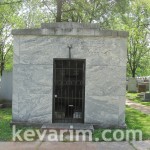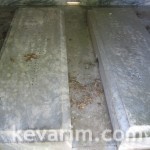Rabbi Chaim Fischel Epstein
חיים פישל ב"ר דוד שלמה
Chief Rabbi, St. Louis, MissouriDate of Death:
Sat. July 5, 1952 -
Tammuz 20 5702
Anyone with biographical information is asked to please send it in.
See CONTACT page for details. Thank you.
Directions to Kever: The Chesed Shel Emeth Society Cemetery is located in St. Louis, Missouri, Location: Aguda Section
Biographical Notes:
Orthodox rabbi. Born in Taurogen, Lithuania, Rav Epstein was recognized for his brilliance at an early age. After studying Talmud at the famed Telshe Yeshiva, he wrote his first book, Chinukh le-Na’ar (a commentary on Aaron Ha-Levi’s Sefer ha-chinukh), at age 16. That same year, he entered the Volozhin yeshivah, studying under its famed leaders, Rav Naphtali Tzvi Yehuda Berlin and Rav Chaim Soloveitchik. At only 18 years of age, he was ordained by Rav Soloveitchik and Rav Shelomo Cohen of Vilna. Notably, he also studied secular subjects, which many other Orthodox rabbis of his time at a gymnasium in Shedlitz and displayed an energetic interest in Eretz Yisroel (Land of Israel). The Rav was affiliated with the Chovevei Tzion movement founded by Rav Shmuel Mohilever. At age 24 he began a series of rabbinical positions, including Grosowa (near Minsk) and Sainee, where he remained until the outbreak of World War I. Toward the end of the war, he was named chief rabbi of an Estonian Jewish region. During this time, the Rav completed a Ph.D. degree and taught Jewish philosophy at the local university. Declining invitations to serve congregations in London and Liverpool, he immigrating to the U.S. in 1923. where he served many communities. Among them Bayonne, NJ; Cleveland; Cincinnati; and Brooklyn. Like many of his colleagues from Eastern Europe, he faced resistance from more liberal lay leaders and congregants regarding standards of Jewish practice, particularly kashrs. Yet his reputation as a scholar assured that many rabbinical colleagues and lay leaders came to him to adjudicate matters of Jewish law. In 1923, he served as a rabbinical judge in a kashrus dispute between two prominent Canadian rabbonim. The Rav wrote several volumes of highly regarded responsa, including Teshuvah Shelemah. A second volume addressing matters of American concern was published in 1940.
The Rav lived his later years in St. Louis, serving as chief rabbi of the United Orthodox community and head of the city’s newly established Va’ad ha-Ir. He remained the leading Orthodox rabbi in St. Louis until his death.
Adapted from: M. Sherman, Orthodox Judaism in America
« Previous: Rabbi Yaakov Tuvia BuchbinderNext: Rabbi Yehuda Meir Shmulewitz »




His sefer Midrash Hachaim:
http://www.hebrewbooks.org/2464
RC Karlinsky authored a book on Rav Epstien’s biography, for a time Rav epstien served as rabbi in Williamsburg, Brooklyn.
His sister was the mother of rabbi Dovid Shlomo Shapiro of Milwakkee author of Midrash Dovid, according to his preface they were descendants from the Noda Biyehuda through his SIL Reb Yosef Hatzadik of Pozne.
Hapardes on his passing 20 Tammuz 5702-1942:
http://www.hebrewbooks.org/pdfpager.aspx?req=12112&st=&pgnum=7&hilite=
Anyway of getting the text off the tombstone?
מורנו ורבנו הרב הגאון מרן ר חיים פישל
ב’ הרב ר’ דוד שלמה עפשטיין אב”ד דקהילתינו
.נפטר כ’ תמוז תש”ב ת.נ.צ.ב.ה
Chief Rabbi Haim Fishel Epstein
1874 –––– 1942
My bracha to klal yisrael is that we should be zoche to more rabbi like Harav Epstein.
More about him: http://www.hebrewbooks.org/pdfpager.aspx?req=12441&st=&pgnum=10&hilite=.
thank you for posting all these links in the comments. My son is writing a paper for his fifth grade class about his family and this was amazing- I am Rabbi Epstein’s great grand daughter.
Anybody knows more about this part of the bio
Declining invitations to serve congregations in London and Liverpool,
He was my great-grandfather. His daughter Miriam was my mother’s (nee Feigenbaum) mother. We were told that he was also offered the position of head rabbi of Israel, which he also declined because I think he wanted to be in America. I should ask my cousin Danny, son of David Epstein, another of the Rabbi’s eight children.
I am the great-grandson of Bernard (Berel) Epstein of Philadelphia, who our family has long believed to have been a brother of Rabbi Chaim Fishel Epstein. I have some verification– much more information in writing than I have committed to memory.
Is the biography of Rav Epstein by RC Karlinsky available? I would like to obtain a copy. Thanks in advance.
The biography is available on Hebrew Books online http://hebrewbooks.org/57397
Is anyone aware what happened to Rav Epstein’s writings?
I am a Jew on my Great Grandfather’s side of our family. To my knowledge, he was a early farmer-immigrant to Pennsylvania, USA (unknown birthdate or burial place – probably around 1870).
I discovered my Jewish heritage in recent years, as my Father, Eugene Shane DeHaven, was born in Paris, IL on October 15, 1909 (deceased).
My Father never spoke about his time (stage – actor) in Vaudeville Theater, Chicago and in early Hollywood, although there were plenty of black & white photographs at home of this time in his acting career.
Since my discovery of my Jewish (Danites-Denmark) identity, I have become an expert in the Tanakh (over five decades actually) and consider myself a self-taught rabbi.
QUSTION: Is there any advice or pointers to where I might begin my search for my Great-Grandfather, Abraham DeHaven, buried to my knowledge in the 1850-70s in Pennsylvania. I turned 75 years old on 9-11-2022 and if you could help in the least bit, please reply as I want to go to Israel and resettle with a dual USA-Israeli passport.
Dean P. DeHaven, CEO, Cambridge Quantum Solution, LLC.
Cambridge, MA 02139
C:408-978-1913